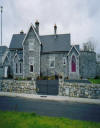 In 1801 the Rathkeale and Newcastle
West Junction Railway (R & N.J.R.) company was authorised to join
Newcastle West with the Foynes Railway line at Ballingrane. Building of
the line was very slow. In 1866 the ten mile branch from Ballingrane was
completed. The forty three mile section from Newcastle West to Tralee via
Barnagh was built in 1870 and they called it the Limerick and Kerry
Railway (L & KR)
In 1801 the Rathkeale and Newcastle
West Junction Railway (R & N.J.R.) company was authorised to join
Newcastle West with the Foynes Railway line at Ballingrane. Building of
the line was very slow. In 1866 the ten mile branch from Ballingrane was
completed. The forty three mile section from Newcastle West to Tralee via
Barnagh was built in 1870 and they called it the Limerick and Kerry
Railway (L & KR)
In the 1920's a noted incident
happened, Anti-government forces halted the train, they then sent the
train towards Newcastle West where the train stopped in a field at the
rear of Bishops street, the only passengers, pigs were killed on
impact.
The train service kept running up
until 31st October 1975. On that date, the last train service brought a
wagon of cement bound for J.J.Phelans. In the 1990's these tracks wee
removed and the great southern trail replaces them. Straddling the
boundaries of Churchtown and Gortbuoy a final landscape feature declares
as terminal railway to Newcastle West.
In 1887, at which stage a line from
Limerick reached to Newcastle West. A 27 mile post measured nearly all of
the distance; station and signal posts were in place. On October 23rd 1866
the railway was inaugurated by way of a special train from Limerick.
Several V.I.P's were on board including the chairman, the Earl of Devon.
At Ballingrane the lavishly decorated train proceeded on to the new track
to Rathkeale where the fine cut-stone buildings, commodious goods store
and cattle pens over the river Deel at Castlematrix via an iron-girder
bridge, 90 feet in width.
From Ardagh the train pulled on to
the line to Newcastle West and followed tracks almost dead level and
straight between the two stations. The last bridge loomed, the town
terminal was in sight. Cascades of cheering wafted up line from hundreds
of townspeople. On the platform a welcome party had assembled. It included
Rev. R. B. O' Brien, parish priest of Newcastle West. On the 1st Jan 1867
the line opened for traffic, with two trains daily to and from Limerick.
Thus the railway became a going concern.